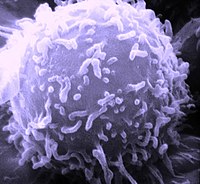
Photo from wikipedia
Understanding the composition of circulating immune cells with aging and the underlying biologic mechanisms driving aging may provide molecular targets to slow the aging process and reduce age-related disease. Utilizing… Click to show full abstract
Understanding the composition of circulating immune cells with aging and the underlying biologic mechanisms driving aging may provide molecular targets to slow the aging process and reduce age-related disease. Utilizing cryopreserved cells from 996 Framingham Heart Study (FHS) Offspring Cohort participants aged 40 and older (mean 62 years, 48% female), we report on 116 immune cell phenotypes including monocytes, T-, B-, and NK cells and their subtypes, across age groups, sex, cytomegalovirus (CMV) exposure groups, smoking and other cardiovascular risk factors. The major cellular differences with CMV exposure were higher Granzyme B+ cells, effector cells, and effector-memory re-expressing CD45RA (TEMRA) cells for both CD4+ and CD8+. Older age was associated with lower CD3+ T cells, lower naïve cells and naïve/memory ratios for CD4+ and CD8+. We identified many immune cell differences by sex, with males showing lower naïve cells and higher effector and effector memory cells. Current smokers showed lower pro-inflammatory CD8 cells, higher CD8 regulatory type cells and altered B cell subsets. No significant associations were seen with BMI and other cardiovascular risk factors. Our cross-sectional observations of immune cell phenotypes provide a reference to further the understanding of the complexity of immune cells in blood, an easily accessible tissue.
Journal Title: Aging
Year Published: 2023
Link to full text (if available)
Share on Social Media: Sign Up to like & get
recommendations!